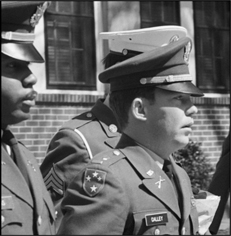
Atrocities, such as torturing or killing of unarmed, nonresisting civilians or prisoners, have been a part of war ever since war began. The most famous international agreements designed to punish those committing atrocities and to spell out rules of warfare on humanitarian issues are the ones established at the Geneva Convention. Additionally, each nation has its own laws. During the Vietnam War, both sides committed atrocities. American atrocities were spontaneous and random acts in direct violation of U.S. military law and MACV directives. In contrast, North Vietnam and the Viet Cong had a written policy that sanctioned and encouraged these acts, including assassination, massacre, and torture. Such acts came to symbolize the brutality of the Vietnam War: the massacre at My Lai, conducted by American troops, and the massacre in the South Vietnamese city of Hue during the Tet Offensive, conducted by Communist forces.

Lt. William Calley is escorted to the Fort Benning stockade to begin his life term in prison for his part in the My Lai massacre.
My Lai was a South Vietnamese hamlet. On March 16, 1968, Lieutenant William Calley Jr. led his platoon into My Lai as part of a search-and-destroy sweep to capture or kill suspected Viet Cong. Though the soldiers found only old men, women, and children, Calley, believing them to be Viet Cong, or Viet Cong sympathizers, ordered his men to attack. Calley was court-martialed for his actions. During his trial it was revealed that as many as five hundred civilians were massacred in what was later called by historians the most shameful act in U.S. Army history.
Hue was the historic cultural and intellectual center of Vietnam. When the Tet Offensive was launched, the Communists managed to seize most of the city. The monthlong battle to retake Hue would become the longest and bloodiest struggle during that campaign. During the fight against American and South Vietnamese forces, the Viet Cong swept through the city, conducting a systematic slaughter of intellectuals, doctors, political leaders, and anyone they judged “a cruel tyrant or reactionary element.”
It was only after the Americans and South Vietnamese forces had recaptured Hue that they discovered what had occurred to the civilian population. During the postbattle cleanup and reconstruction of the city, they discovered mass graves of those slaughtered and executed. Searchers found 2,810 bodies, and additional records estimated that as many as 5,700 people—including foreign nationals—may have been killed by the Viet Cong.